"Indian Heads" and other humanoid rocks
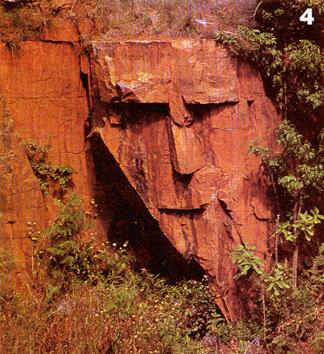
Credit: Ranger Rick magazine (National Wildlife Federation) / Leen van der Slik - Earth Scenes
I sometimes get a curiosity itch and I am wondering how many "faces"
are seen in landforms. From my childhood I remember the "Sleeping
Indian" mountain seen in the Colorado Rockies from the area of Walden,
CO. As a child I tried to see the "sleeping indian" that the adults
were talking about and, sure enough, found one. A couple of years
later, I found out that what I had pegged as the Sleeping Indian was
really Owl Mountain (Owl Mountain looks like the supine form, perhaps
under a shroud after a brave death in battle, of an Indian Chief. You
can trace the rise and fall of head, chest, and feet, and an extra
lump that must be the warrior's weapons beneath the buffalo skin.) As
it turned out, the real Sleeping Indian is just a head facing skyward,
and you can see the profile of the face. Through binoculars the
Sleeping Indian has an extra lip, but is still startlingly lifelike. I
believe the name of the peaks is "the crags," and, as one might expect, the crags resemble a face only from one particular viewing direction.
Images of Sleeping
Indian: [Morning Sun] [Afternoon Sun]
Image of Owl Mountain |
[Full Size]
So now I am collecting "faces" seen in natural formations. (I am not the only one! See Matt Bergstrom's
Stone Faces Gazetteer. Also, "Cara" pointed me to a book called "Natural Likeness: Faces and Figures in Nature" by John Mitchell. )
- One landmark is Nanabijou, the "sleeping giant" from
Ojibway tradition. Nanabijou can be seen from the harbor of Thunder
Bay, Ontario, resembling the body of a sleeping, 7-mile-long giant.
This giant was once (legend has it) Nanabijou, the spirit of the deep
sea. Long ago, Nanabijou entrusted a loyal tribe of Ojibway Indians
with the secret location of a rich silver mine on Silver
Islet. Nanabijou warned the Ojibway not to reveal the mine to the
white men or he would be turned to stone and the tribe would
perish. The rival Sioux nation, envious of the beautiful silver
ornaments worn by the Ojibway, sent a scout to discover the mine's
location. The scout was successful. Later, the Sioux took several
silver pieces to the white traders and revealed the secret of Silver
Islet. Immediately, a great storm broke over the land, turning
Nanabijou to stone.

Alternate picture
Credit:
Sleeping Giant Bottle Club
- "The Great Stone Face," or "Stoneface" is located in Pennington Gap, Virginia. It is said to mark the entrance to Cherokee holy ground.
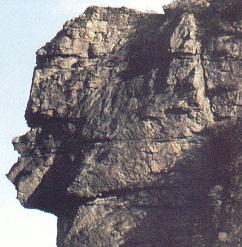

Credit: Sarah W.
- On the coconut coast of Hawaii lies the Sleeping Giant (Nounou
Mountain) between Wailua and Kapaa that looks like the figure of
a man. Legend has it that this was a pesky giant who ate
constantly. The villagers of Wailua tricked him into eating a
great number of rocks hidden in a vast quantity of fish and
poi. The giant was so full that he lay down to nap, and has not
(to date) awakened.
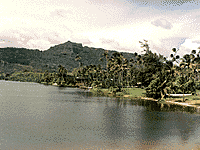
Credit: Kauai Visitor Information
- Sleeping Ute Mountain lies on the "Ute Mountain Ute Reservation"
in southwestern Colorado and northern New Mexico. The mountain's
angular crests fit together to form a sleeping man facing the Ute
Mountain Ute Reservation. In Ute tradition, the mountain is a grand
warrior resting from battling against great evil that threatened the
Utes. The 3-day Sun Dance is held every year on a sagebrush flat over
the Sleeping Ute's heart. Visitors must have a Ute guide to visit the
mountain. Most of the 9977-foot Sleeping Ute mountain is uplifted
layers of sandstone and shale, but his toes are volcanic necks, lava
that pushed through the shale and sandstone. In the picture below, his
(or her) head is to the right, and folded arms, hips, knees, and toes
stretch to the left.
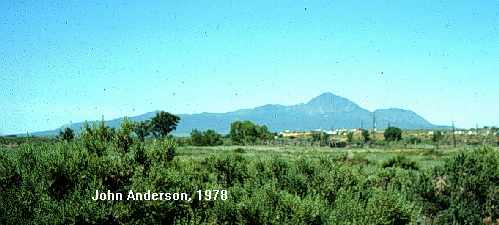
Credit: John Anderson
- A "Sleeping Indian" near Jackson, Wyoming.
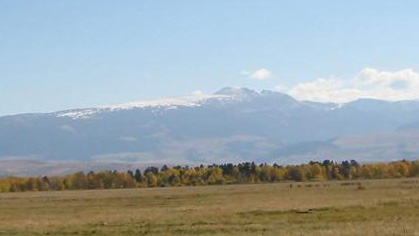
Credit: Tad Brunye
- Another "Sleeping Giant" is formed by the part of the Absaroka Range near Livingston, MT. Without late afternoon shadows it is hard to see the face.
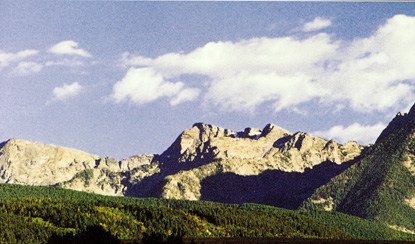
Credit: Terry G. Smart
- The "Old Man of the Mountain:" In Franconia Notch, on the side of
Cannon Mountain sat the Old Man of the Mountain. A natural stone
formation, it was the symbol of the state of New Hampshire. Until 2003, many
of the rocks were held in place with steel cables and turnbuckles. A
rock climb on Cannon Cliffs goes right past the Stone Face site.

New Hampshire's "Old Man of the Mountain"
Folklore.
Rock Fall!
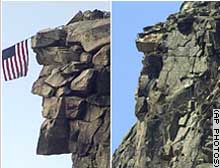
On May 3, 2003 or a day or two before, much of the "Old Man" fell off.
Governor Craig Benson has said that the 40-foot profile should be restored,
as it is New Hampshire's (the Granite State's) most recognizable symbol.
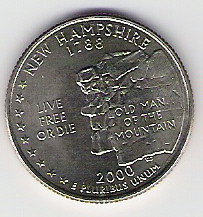
- The Devil's Head of North Carolina, above Rocky Broad River.

- Mount Tamalpais, north of San Francisco, is said to resemble a
sleeping indian maiden.
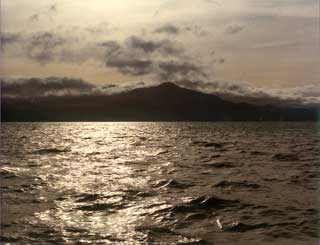
Credit:
Terry Marasco, www.tmarascoselections.com.
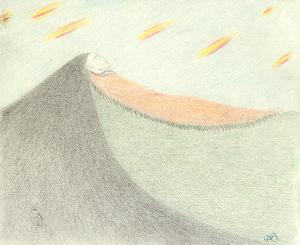
Credit: Bill Jacobson. Pencil
1994. www.starhawk.com.

Mount Tam on a bed headboard!
Credit:
www.tamalpais.com.
- Man's Face Rock near Green River, WY.
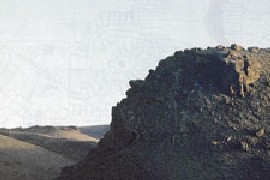
- Profile Rock, about 2/3 of the way up Poudre Canyon, north of
Fort Collins, CO.
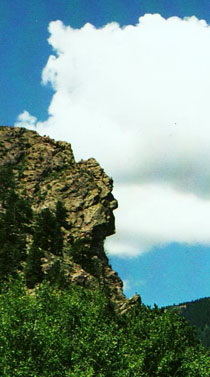
Credit: my own snapshot. (alt.)
- Old Man of the Park, near Sundance, WY.
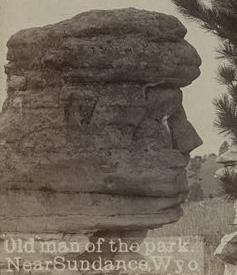
- In Georgian Bay, near Beausoleil Island National Park, Ontario,
Canada, there is an island called Giant's Tomb. According to native
legend, Kitchi-Kiwana, the last of a race of giants, fell with a
mountain in his arms. The mountain shattered into the 30,000
islands. The indentations of his shoulders can be seen on his favorite
island, Beausoleil, where he returned to sleep each night. When he
died, the natives covered him with rocks to form what is now called
Giant's Tomb Island. The great god Manitou lights the fires of the
northern lights to guide the spirit of Kitchi-Kawana whenever he
visits the islands. (Thanks to: Nathan Wendel)
- In the pages of Country Magazine I found a photo of Indian Head Rock, near
Choteau, Montana. I am trying to find
out why it is named "Indian Head Rock" (I sure can't see anything humanoid here).
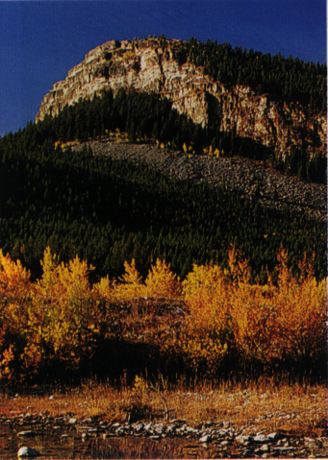
- Previously unnoticed face. Eagle Cap Wilderness Area, Oregon.
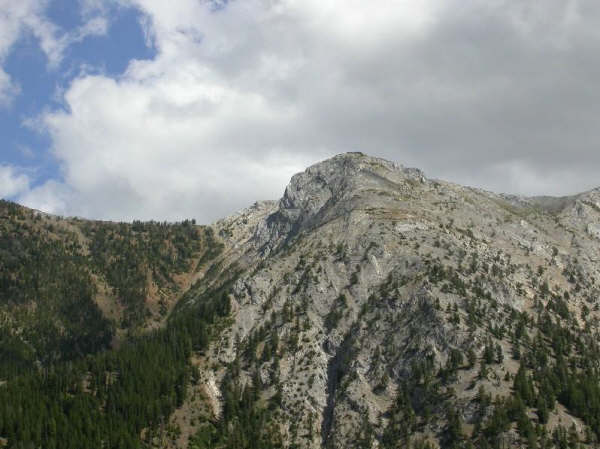
Credit: Ted Werth
- This one is "lion's head rock" near Vail, Colorado.
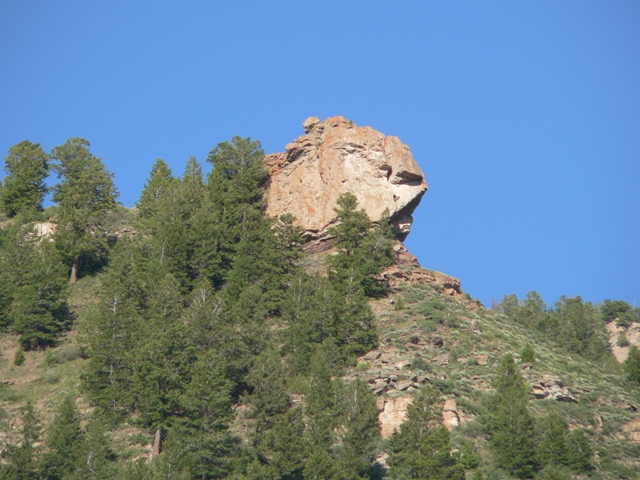
Credit: Michael Thelen
- This troll is in Iceland.
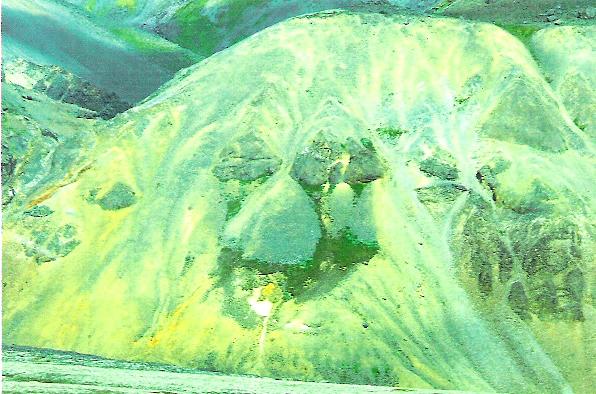
Credit: Carol Smith
- There is a formation called Frankenstein Rock. It is near Chelan, WA, and locals will occasionally paint 'enhancements' on the stone to exaggerate the frightful aspect. But this one illustrated is Lincoln Rock, near Orondo, WA.

Credit: Michael Rawls
- There is a Profile Rock in Massachusetts, also known as the Old Man of Joshua's Mountain.
- A Sleeping Giant is seen in the Garden of the Gods near Colorado Springs, CO. The left is the "feet" end and the right is the "head" end.
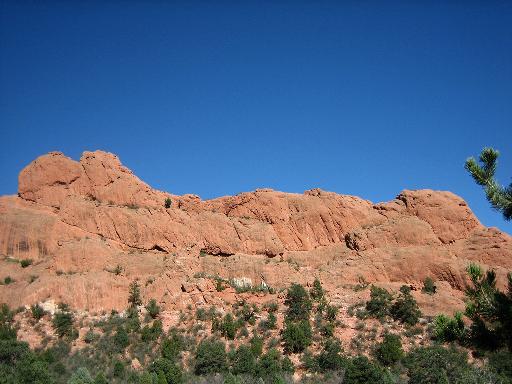
Credit: Stephanie Quinn
- Here's a bit of a different take: a satellite image of an area near Medicine Hat, Alberta. I think this is an awesome image!

Area map. Credit: Tom Finnell
- A rock in a temple near Yamagata, Japan.
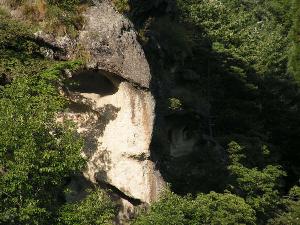
Credit: C. Tercero
- Sphinx Rock in Wastwater, England; a reclining woman seen near
Mt. Ixtaccihuatl, Mexico; the Old Woman, found in France; and Vartan
Rock in Armenia are all covered in the Mitchell text mentioned above
(many thanks to "Cara!"). The last has a charming legend:
. . . the rock near Chermoog in Armenia forms an image of the martyr
St. Vartan. A legend describes how this came about. In the 5th century
A.D., the Armenians rose against the Persian invaders, and Vartan led
them in the battle of Averayr, near Chermoog, where he and his small
army were slaughtered. On a Sunday after the battle, the Armenian
people went out to a nearby valley to mourn their loss and to pray for
the return of their heroic leader. It is accounted a miracle by the
Armenian church that there, before their eyes, appeared the face of
St. Vartan, perfectly figured in rock. This apparition is said to have
a most comforting effect on the Armenians' sprits.
- "The Sphinx" in the Bucegi Mountains of Romania is a popular spot for tourists.

Credit: E. Szabo
- A Sleeping Giant north of Helena, Montana is noted in the Stone Faces Gazetteer.
- Need a clue on a Praying Lady near Dayville, Oregon . . . (thanks for the tip, John M.)
- The "Old Man of the Gorge" in Chesterfield Gorge in West Chesterfield, MA. It's a profile.
(thanks for the tip, Mark L.! Image credit: old postcard. Click to zoom.)
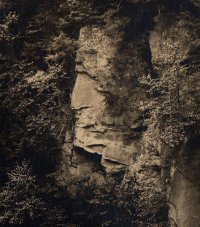
- This one is awesome.

Credit: John Anderson
Differential weathering of basaltic rock in Hawaii produced this remarkably recognizable profile of John F. Kennedy. It is located on Maui, in the Iao valley. (Thanks for the location information, Larry Henderson!)
- Seeking information and especially a picture of Blo Degbo in Liberia...
If somebody has information or pictures about landform faces, please
email me at  . I
am interested in all such stories.
. I
am interested in all such stories.
The "face on Mars" is still occasionally mentioned, at least in the
"Weekly World News" tabloid. (Erm. Oops. That tabloid is now out of
business.) Here's the basic story. In 1976, the Viking orbiter took a
series of images of the Martian surface that were later combined and
processed to yield the following image:
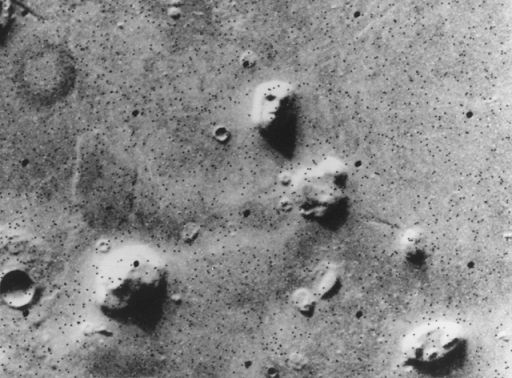 Do you see the small face? Weekly World News published this, er, artistic version that it claims is another NASA photo.
Do you see the small face? Weekly World News published this, er, artistic version that it claims is another NASA photo.
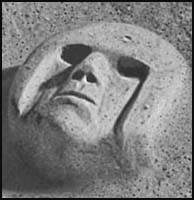 In reality, the Mars Global Surveyor did take a higher resolution (14 meter) photo of the same mountain, from a different angle. Here is a portion of that picture.
In reality, the Mars Global Surveyor did take a higher resolution (14 meter) photo of the same mountain, from a different angle. Here is a portion of that picture.
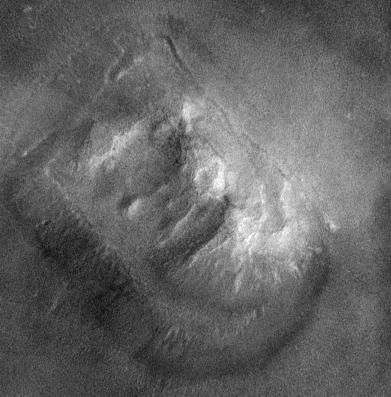 I and other reasonable people (who were never impressed by the
original "face of Mars" picture anyway) conclude that there is no face
on Mars, and certainly no need to conjure up a Martian civilization
that was humanoid and interested in making large facial
sculptures. See the Mars Face
Page at Malin Space Science Systems for more information.
I and other reasonable people (who were never impressed by the
original "face of Mars" picture anyway) conclude that there is no face
on Mars, and certainly no need to conjure up a Martian civilization
that was humanoid and interested in making large facial
sculptures. See the Mars Face
Page at Malin Space Science Systems for more information.
Or is there a face on Mars after all? Mars Global Surveyor also found the following suggestive image. Crater? Or cosmic happy face? You decide . . .
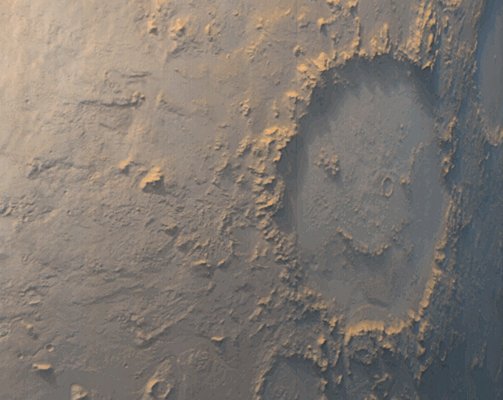
Other faces. These don't really count, as they aren't landforms! They are all organic in origin, in fact.
This is a frog butt.

These are from the Gingko Petrified Wood visitor's center: faces that appear in cut, polished sections of petrified wood. Dubbed "Moses" and "Girl" by the staff there.


This totally does NOT count!































 . I
am interested in all such stories.
. I
am interested in all such stories.






